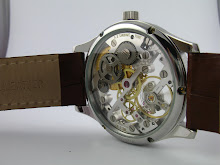The first thing to be done is to drill a pilot hole for the hub. This is always smaller than the required dimension and with the planed side facing down. The idea is that, provided the set up is true and rigid, the surface & the hole are perpendicular.

The job is mounted on a suitable turning arbour. In the picture below you can see a set of vintage turning arbours I acquired some time ago. These allow you to turn jobs with holes of various diameters.

Now, the correct diameter for the hub is marked on the turns.

Here it is, I like to make a marking on both sides. Also, the hole has been broached to fit the hour wheel.

The hub and the rest of the hand is filed down. Please note that the dimensions are on the larger side since some more material will be removed during final adjustment & polishing.
 Finally, both the surfaces are planed once again on the polishing tool.
Finally, both the surfaces are planed once again on the polishing tool.  The rough hand is ready. It is still soft. The hand will only be hardened & tempered after final adjustments.
The rough hand is ready. It is still soft. The hand will only be hardened & tempered after final adjustments.Aditya

